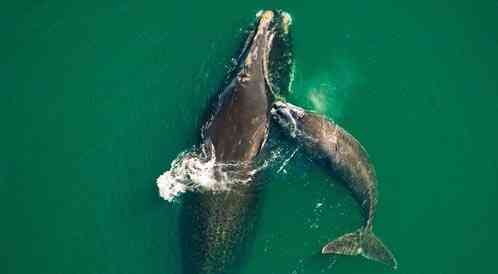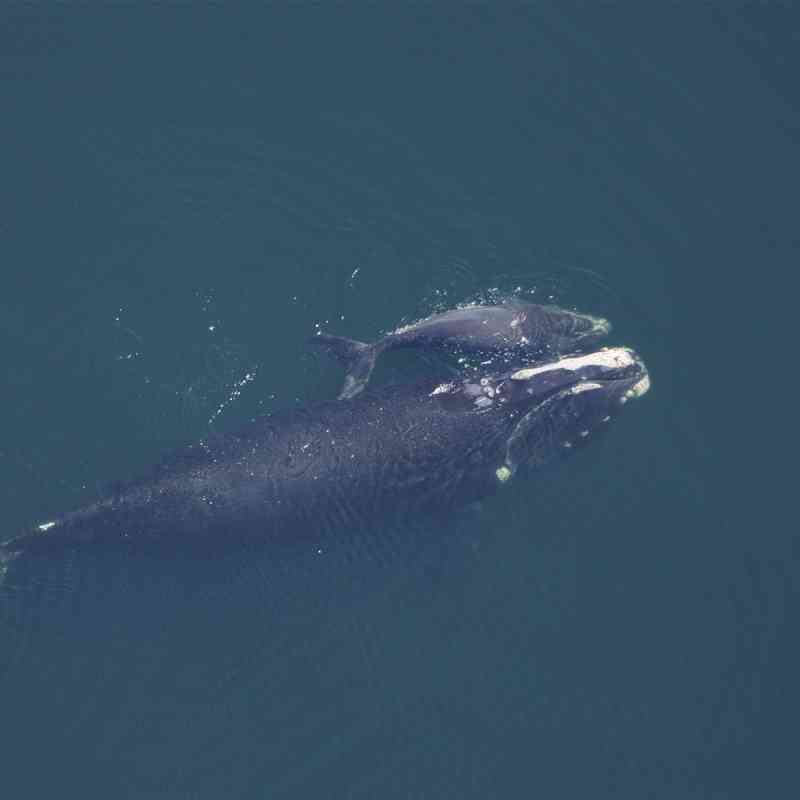Help is on the way for right whales in crowded East Coast shipping lanes
by Heidi Ridgley

© Brian Skerry / National Geographic Stock
The sun hasn't yet risen over the deep, cold waters of Massachusetts Bay, as a crew assembles on the deck of the U.S.S. Connecticut and gets ready to hoist a giant buoy—and the equipment tethered beneath it—out of the water. Part of a high-tech network of underwater listening devices working to detect North Atlantic right whales in the shipping lanes off Boston, this contraption and four others are getting their batteries replaced today.
It's no easy feat. Each device weighs about 800 pounds, and this one is covered in algae. "Put on your wetsuits," says James Dunn, an engineer with Woods Hole Oceanographic Institution, anticipating the splashes of ocean muck to come.
Dubbed the "right whale listening network" and developed by the Cornell Lab of Ornithology along with Woods Hole, the system is a promising and ground-breaking solution to the endangered whale's biggest problem: ship strikes.
As these slow behemoths migrate between their northernmost range in the Gulf of Maine and their calving grounds off the coasts of Georgia and Florida, they must move through some of the busiest ports and shipping lanes in the world. And with global shipping traffic on the rise—in 1998, there were 87,000 registered ships weighing more than 100 gross tons along the eastern seaboard, compared to 31,000 in 1950—the situation for right whales is getting ever more dire.
Before 1991, right whale strikes were uncommon, with only seven documented between 1972 and 1990. But from 1991 to 2005, at least 17 North Atlantic right whales were known to die in collisions—one to two per year—proving that the 40- to 80-ton leviathans can't compete with 90,000-ton tankers. If it doesn't die on impact, often the whale dies from loss of blood within hours—especially if a segment of the tail is severed or a vital organ gets punctured.
Right whales only give birth every four years and they do not begin to reproduce until age eight. That makes every North Atlantic right whale—there are only 350 to 400 individuals left—crucial to the survival of the species. (There are also about 1,000 North Pacific right whales and 7,500 southern right whales in the Southern Hemisphere.) According to the National Marine Fisheries Service, the loss of even one female could lead to the population's extinction.
The listening network, started last year, is a system of submerged microphones (or hydrophones) attached to 10 buoys spaced five miles apart across a high-traffic zone, which allows researchers to "eavesdrop" on the whales. Each hydrophone can pick up sounds within five miles. "Now for the first time, we can hear up-to-the-minute calls of right whales in real time and see where those whales are in the ocean off Boston and Cape Cod so we can alert ship captains to their presence," says Christopher Clark, director of the Cornell lab's bioacoustics research program. Clark describes the network as an "environmental nervous system."
The system uses a small submerged computer that "listens" to the sounds picked up by the hydrophone. When it registers what could be a "whoop" or "moo" from a right whale, the sound is stored in a file and the computer sends a message to the Cornell bioacoustics lab via a satellite phone system. At the lab, an analyst reviews the recording. If a right whale is confirmed, a message is sent to ships in the area telling them to reduce their speed. Until December, only certain ships were required to drop their speed to 10 knots (11.5 mph) and position a lookout to search for whales by sight.
Today every ocean-going vessel longer than 30 feet is required to comply with the 10-knot speed limit within 20 nautical miles of East Coast ports during migratory and calving season—whether they are part of the call network or not. (According to government researchers, this area around ports is where about 83 percent of right whale sightings occur.) The speed-limit regulation was pushed through by the National Oceanic and Atmospheric Administration despite protests from the shipping industry and strong resistance from the Bush White House—and following a lawsuit filed in 2005 by Defenders of Wildlife and other conservation groups.
"This law, in combination with new developments like the right whale listening network, represent important steps toward reducing right whale ship strikes on the East Coast," says Chris Tremblay, a marine biologist and the listening project's coordinator at Cornell. "The listening system can still be crucial for the whales, especially if it is expanded up and down the seaboard. Every commercial ship that comes into a U.S. port is required to have an AIS system aboard—an Automatic Identification System—that tracks the ship's direction and speed to signal other ships. Our system could be used to send real-time right whale detections to any ship in the area."
Eventually, the system might also be used for real-time monitoring of other species, too, adds Eric Spaulding, an engineer at the lab. "As the number of systems in operation increase, installation and operating costs will go down, making it more accessible for research and government entities," he says.
The listening network began after the National Marine Fisheries Service granted Texas-based Excelerate Energy permission in 2007 to build a new liquified natural gas port near Stellwagen Bank National Marine Sanctuary, a frequent haunt of right whales 25 miles east of Boston Harbor. This essentially allowed Excelerate's tankers to cross a portion of the sanctuary.
As a compromise, the federal government required that the listening system be put in place to protect right whales—and that Excelerate foot the bill, estimated at $47 million for the 25 to 40 years that the port is expected to remain open. "Permits were issued only after effective precautions were put in place, and the government will carefully monitor every step in the process," says Tremblay, just before the Connecticut leaves port near Martha's Vineyard to sail up and around Cape Cod to Massachusetts Bay at a 10-knot crawl.
And now, with the sky above the ship a mass of gray swirls at dawn, one of the engineers shoots an acoustic signal through the water to tell the buoy to release from the anchor. The crew begins reeling the buoy in. But the line is stuck, and it takes about 50 more minutes of maneuvering before the buoy gets hauled aboard, along with the hydrophone and anchor. After replacing the battery, the men work in reverse, dropping the 1,800-pound anchor last. When the weight hits the ocean bottom, some 500 feet down, the buoy snaps into position.
The vessel then moves on, en route to the next buoy a half-hour away, while the captain keeps a watchful eye out for whales. It's September and right whales aren't likely to be here. They tend to frequent the waters around Cape Cod from December through April, but no one aboard wants to run any risk of hitting one.
There's a reason right whales meander around at a leisurely pace. Unlike many other whales that must chase their food down, right whales feed by sifting plankton—which float along at the whim of ocean currents—through their baleen. "At times when they are feeding at the surface, right whales just motor along slowly, like they are mowing the lawn of food," says Tremblay. In contrast, fin whales and humpbacks, which also swim the Atlantic coast, catch their meals, so they evolved to move faster. This means that in today's congested oceans, these animals are more able to move quickly out of the path of an oncoming ship. Fin whales can travel up to 20 knots, humpbacks 12 knots. But right whales max out around 10.
This slow speed also contributed to the population's decline in the past: It made them easy to harpoon. It's one of the reasons whalers deemed them the "right whale" to kill. Their unusually thick layer of blubber also kept them afloat longer than other whales after they died. Commercial whaling was finally banned in 1935—but by then there were only a few dozen North Atlantic right whales left.
Those that managed to stay afloat in the following decades have been threatened not only by ship strikes. They also face entanglement in fishing gear, industrial and agricultural contaminants that follow rivers to the sea, and an increasing level of noise pollution from shipping traffic, which makes it ever harder for whales to communicate with one another. (Earlier research on the sounds of different whale species led Clark to conclude that before the "acoustic smog" caused by modern ship traffic, a whale's song could have resounded from one ocean basin to another.)
But with new speed limits in place—in essence, a whale "school zone"—and an innovative listening system, perhaps collisions with container ships, tankers, cruise liners and fishing boats can be a threat of the past.
That's what Tremblay and the rest of the crew continue to hope for as they tidy up the deck, unsnarl the heavy ropes and take off their wet suits. The sun is setting, all five buoys are up and running again and a container ship moves across the horizon as the U.S.S. Connecticut heads back around the cape to crawl its way home.
Senior Editor Heidi Ridgley spent two nights in a boat bunk to report on this story. To follow real-time right whale detection, check out listenforwhales.org.
Related


